
 In 1974 Don Gardner started a prairie development project on a 7.3-acre former permanent pasture on the south side of Kempton in Mona Township, Ford County, Illinois. The procedure involved the introduction of native prairie plant species by hand seeding new plots progressively across the field (see map above) over a period of 17 years (see table below for details). In 2001 an 8.0 acre [insert correct number] agricultural field adjacent to the east side of the field was added and prairie reconstruction work there has continued since then. [add link to new map] A 2012 survey [add link to plant list identified about 158 native species and 45 aliens present on the site. In 1995, this project was included in the Illinois Natural Areas Inventory as a Category V site, a Natural Community Restoration.
In 1974 Don Gardner started a prairie development project on a 7.3-acre former permanent pasture on the south side of Kempton in Mona Township, Ford County, Illinois. The procedure involved the introduction of native prairie plant species by hand seeding new plots progressively across the field (see map above) over a period of 17 years (see table below for details). In 2001 an 8.0 acre [insert correct number] agricultural field adjacent to the east side of the field was added and prairie reconstruction work there has continued since then. [add link to new map] A 2012 survey [add link to plant list identified about 158 native species and 45 aliens present on the site. In 1995, this project was included in the Illinois Natural Areas Inventory as a Category V site, a Natural Community Restoration.
With this and other reconstruction or restoration efforts it is unlikely that it will be possible to totally reconstruct prairie as it existed in pre-settlement times. There are probably several reasons including possible climate changes. However, the principle one is the invasion by the many alien plant species with which the native prairie did not have to contend. Fortunately a healthy prairie will displace most of these, but maybe not totally and in the cases of a few species, not at all. The intent of this project is to establish a mix of prairie species that probably grew in the region in pre-settlement times.
History
The project site is in the Grand Prairie section of the Grand Prairie Division of east central Illinois. The first written records found for the immediate area were dated 27 April 1834. It was then that the United States public land survey was conducted. The survey indicates that all of what is now Mona Township was prairie, with marshland in the southeast portion described as the “Vermilion Swamp.” Field notes for the survey of Section Six, in which the project is located, describe it as “rich first rate prairie.” Mona Township was organized in 1870. Major settlement occurred about that time. Population growth was encouraged by construction of the Bloomington-Kankakee branch line of the Illinois Central Railroad, and the village of Kempton was developed on this newly established line in 1878.
One of the early settlers was J.N.Winstanley who came to the area in 1868. He came to Dwight by train and then walked to what later became Kempton. Years later he wrote, “One who has never seen a prairie before settlement can hardly realize the change that has taken place. When there were no buildings, groves of hedges to obstruct the view, and no smoke from chimneys and railroad trains to make a haze in the atmosphere…In the summer there was a profusion of wild flowers from the modest little violet and delicate wild lily to the goldenrod and coarse rosinweed blossoms that appeared to abound everywhere. Prairie fires were another feature of those days. While beautiful to behold, they were not infrequently dangerous. It was not uncommon to plow several furrows around the buildings and stacks of hay or grain. And even then if the wind was high, there was great danger of the fire leaping across the plowing and becoming unmanageable. Those who have seen the Vermilion swamp on fire when in its primeval state have seen a spectacle they are not likely to forget.”
Another early settler was Wright Kemp, who was instrumental in forming the village and owned land including the present prairie restoration. He came from Morris in Grundy County to “Grand Prairie, Ford Co.” in 1866. He described that journey, by way of Dwight, as traveling “across the unbroken prairie.” The 1884 Historical Atlas of Ford County Illinois, in which his comments appear, also describes northern Mona Township as “a fine body of undulating prairie land.”
Two subsequent owners of the restoration site used it as pastureland to graze dairy cattle throughout the early and mid portions of the twentieth century. Older residents of the community stated that the site had been permanent pastureland from at least 1900. It was their opinion that the field had never been tilled. Grazing ceased in 1965 and for several years the seven-acre field received only annual mowing. Although some prairie species were present, it gradually evolved into an old field dominated by cool season alien grasses and weedy forbs such as Daucus carota (wild carrot) and Aster pilosus(hairy aster).
Methods
In 1974 a systematic effort was started to introduce prairie species. From then through 1990, 28 plots were established on the core restoration site (see map above). Each year an additional portion of the field was seeded. The size of these plots (see table below for details) depended upon the amount of hand collected seed that was gathered the previous year. In order to maintain central Illinois ecotypes, all seed was collected in Illinois and within 120 miles of Kempton. One plot (19) was left as a control and approximate one-meter strips were left between plots as a refuge for existing prairie species. Over the years there has been progressive encroachment of prairie species onto these areas.
Before restoration work started, the principal grasses in the field were Poa pratensis(Kentucky bluegrass), Bromus inermis (Hungarian brome), Phleum pratense (timothy),Dactylis glomerata (orchard grass), and Elytrigia repens (quack grass). Frequent adventive forbs were Daucus carota (wild carrot), Leucanthemum vulgare (ox-eye daisy),Asclepias syriaca (common milkweed), Aster pilosus (hairy aster), Achillea millefolium(yarrow) and Cirsium arvense (Canada thistle). Surviving native species were found in scattered low-density populations and along previous fence lines.
Several tillage methods were tried on the various plots. They ranged from moldboard plowing and developing a fine particulate seedbed to chisel plowing to disking to spraying with a glyphosate herbicide followed by only light harrowing and then hand seeding. This latter procedure has proved to be the method of choice on a site that has not been growing tilled row crops. It creates the least amount of soil disturbance, reduces the possibility of erosion, and brings fewer seeds of weedy species to near the soil surface. In most years the seeding dates fell within the last ten days of May or the first ten days of June. Regardless of the soil preparation method used the plot was always rolled following seeding in order to achieve better seed-soil contact.
Seed
Freshly collected seed was dried indoors by spreading it in a shallow layer that was regularly turned. No artificial heat or forced air drying was used. Storage of the dried seed was in a cool, dry basement. Seed of species for which there were small collections was frequently stored in refrigerators. Also, damp stratification was occasionally used, but insufficient refrigerated storage made this procedure impractical on any large scale.
Seed from spring-flowering taxa were often planted in late summer. After drying, the seed of species such as Dodecatheon meadia (shooting star), Pedicularis canadensis(lousewort), Phlox pilosa (prairie phlox), and Sisyrinchium albidum (common blue-eyed grass) were planted in established restoration plots. Small open areas were selected, and the soil was agitated with a three-pronged hand cultivator. Seed was scattered on the surface, the soil agitated again, and then compressed. It was felt that this method was more conserving of seed than broadcast application when establishing a new plot in which heavy weed competition was assured. However, spring seeding on new sites with the above named species also proved successful.
For about the first ten years of the project, legume seeds of the genera Amorpha,Baptisia, and Dalea were treated immediately before planting with appropriate Rhizobiuminoculant from Nitragin Corp. Before inoculation, Amorpha canescens (leadplant),Baptisia alba (white wild indigo), and Baptisia bracteata (cream wild indigo) were scarified using a vibrating bench sander.
Dalea candida (white prairie clover), Dalea purpurea (purple prairie clover), and Baptisia alba germinated well, usually appearing the first or second year after planting. Amorpha canescens often, though not always, required several years to appear.
In later years scarification was continued, but the legume seed was no longer treated with inoculant. The appearance of increasing numbers of native legumes may suggest that the required strains of Rhizobium are established in the soil. Other legumes such asAstragalus canadensis (Canadian milk vetch) and Lespedeza capitata (round-headed bush clover) were planted without inoculation or scarification. They also have become established.
A prairie nursery was established within the field (Plot 8A) and used to propagate species that were difficult to establish by direct field seeding or for which only small amounts of seed were available. This provided a source of additional seed and for transplants. Short nursery rows were seeded, resulting plants were increased primarily by division, and the rows lengthened.
Fire
Fire has been a principal management procedure. Burns are conducted in late February or during March. Later burning is avoided since the site has a good complement of spring forbs that start emerging in early April. Leaving the previous year’s growth in place over winter aids in prevention of erosion and provides shelter for wildlife. Fire lanes are mowed late the previous summer along areas where there is risk of escape. A day is selected for burning when the wind is in an appropriate, usually westerly, direction and backfires are started along the fire lanes. Once these are secured so there is no chance of the fire jumping across them the head fire is started. A portion of the prairie is left unburned each year as a refuge for certain insects or other arthropods associated with prairie that overwinter above ground as eggs or larvae in leaves or stems.
Weed Control
In spite of the fact that annual weedy plants often seemed to overwhelm new plots they did not prove to be a lasting problem. The predominant pioneering species included Chenopodium album (lambs quarters), Amaranthus retroflexus (rough pigweed), Ambrosia trifida (giant ragweed), Ambrosia artimisiifolia (common ragweed), and Erigeron annuus (annual fleabane). They were followed in the second and third years by another wave of unwanted species. These included Daucus carota (wild carrot). This biennial had invaded the entire field before restoration, and by midsummer was the dominant forb cover. It was expected to be the cause of substantial difficulty in restoration management. However, the concern proved unnecessary. D. carota remains present in the field, but in greatly reduced numbers with few flowering individuals. It has been succeeded to a great extent by native species.
Other biennial aliens in this second wave of succession were Melilotus alba (white sweet clover) and Melilotus officinalis (yellow sweet clover). Their growth appears to respond favorably to burning, and they continue to persist. Their populations vary from year to year, but have shown an increase over time. The problem was attacked vigorously starting in 2002 using a combination of spot spraying with herbicides and hand weeding. The herbicide that has proved to be the most useful in this instance is the amine form of 2,4-D. A problem with 2,4-D is that it may volatilize after application and the drift can damage broad-leaved plants in the area. The amine form is considered to have low volatility and it has not caused serious peripheral damage on this site. However, use of any herbicide on a richly diverse prairie can be dangerous unless great care is taken. Starting in late April when Melilotus has emerged repeated sweeps are made across the field using a backpack sprayer to spot spray. These sweeps are continued until mid-summer when surrounding prairie plant growth has reached a height that makes spraying difficult. Then the plants are hoed at or below ground level or pulled. The result has been that second year plants have been destroyed and do not develop seed. However, there is a continuous influx of first year plants from what must be a vast seed bank in the soil. Unless a better procedure is developed this labor intensive method will be continued.
Expansion
 In 2001 an approximate eight acre agricultural field (see map above) adjacent to the east side of the project was purchased. Prairie plant species are being seeded onto most of this site (Areas C & D) and a small seasonal wetland (Area B) is being re-established. In addition a 0.75-acre wooded area (Area A) is being improved with removal of alien tree species and introduction of more natives. In 2012 additional farmland was purchased south of Kempton. It is contiguous with the property that contains the prairie project and borders a railroad-right-of-way that has quality prairie remnant. A moraine hill on this property that contacts the railroad, and known locally as Sugarloaf, has become the site of the next prairie reconstruction project.
In 2001 an approximate eight acre agricultural field (see map above) adjacent to the east side of the project was purchased. Prairie plant species are being seeded onto most of this site (Areas C & D) and a small seasonal wetland (Area B) is being re-established. In addition a 0.75-acre wooded area (Area A) is being improved with removal of alien tree species and introduction of more natives. In 2012 additional farmland was purchased south of Kempton. It is contiguous with the property that contains the prairie project and borders a railroad-right-of-way that has quality prairie remnant. A moraine hill on this property that contacts the railroad, and known locally as Sugarloaf, has become the site of the next prairie reconstruction project.
Contact information: Don Gardner, 3584 North 1300 East Road, Kempton, IL 60946; email gardo@frontiernet.net.
Images from the Prairie
Seasonal Changes on the Restoration
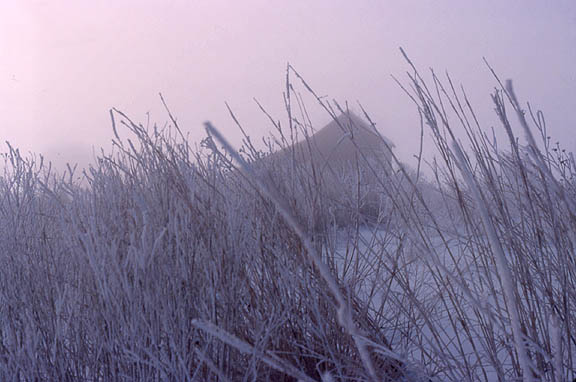




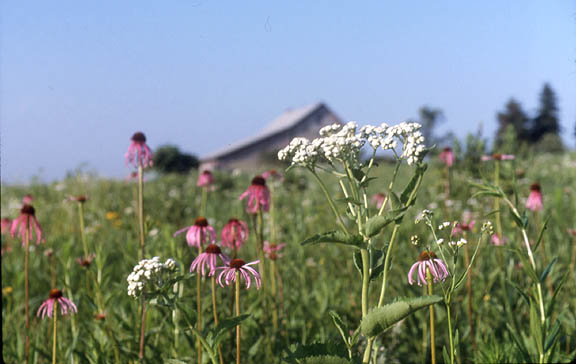




Nursery
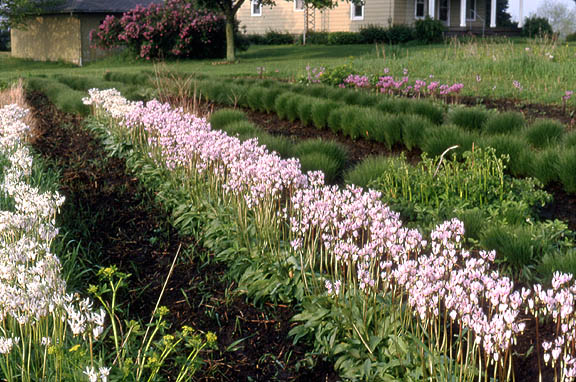
Historical Perspective




- View from a similar position in spring 2004
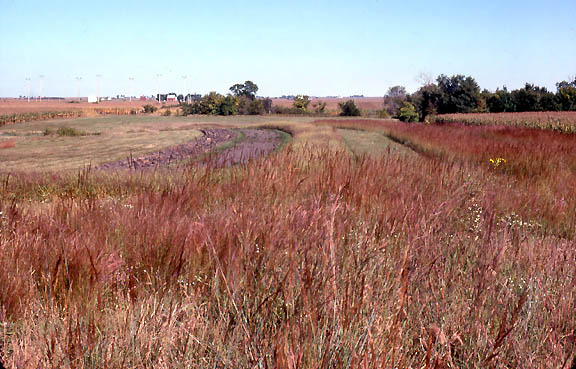
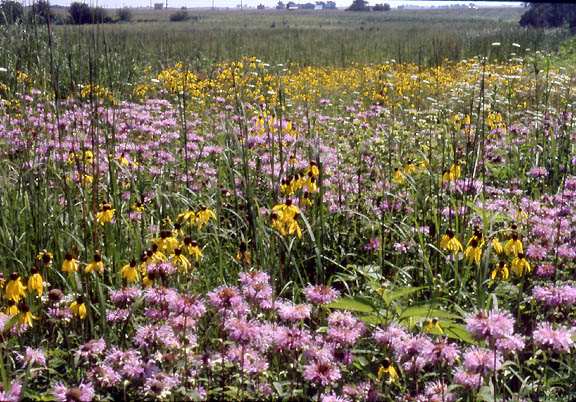


Gardner Restoration Planting Years and Individual Plot Sizes
| Plot | year | Area in | Area in |
| Number | planted | square feet | acres |
| 1 | 1974 | 1,925 | 0.044 |
| 2 | 1975 | 8,026 | 0.184 |
| 3 | 1976 | 6,256 | 0.144 |
| 4A | 1977 | 2,230 | 0.051 |
| 4B | 1977 | 12,166 | 0.279 |
| 5A | 1978 | 3,384 | 0.078 |
| 5B | 1978 | 18,222 | 0.418 |
| 6 | 1979 | 13,164 | 0.302 |
| 7 | 1980 | 12,520 | 0.287 |
| 8A | 1981 | 3,524 | 0.081 |
| 8B | 1981 | 13,678 | 0.314 |
| 9A | 1981 | 10,194 | 0.234 |
| 9B | 1981 | 11,239 | 0.258 |
| 10 | 1982 | 11,660 | 0.268 |
| 11 | 1983 | 7,266 | 0.167 |
| 12 | 1984 | 7,366 | 0.169 |
| 13A | 1985 | 2,486 | 0.057 |
| 13B | 1985 | 8,784 | 0.202 |
| 14 | 1986 | 12,720 | 0.292 |
| 15A | 1987 | 9,415 | 0.216 |
| 15B | 1987 | 6,311 | 0.145 |
| 16A | 1988 | 4,519 | 0.104 |
| 16B | 1988 | 6,095 | 0.140 |
| 17 | 1989 | 6,748 | 0.155 |
| 18A | 1990 | 20,548 | 0.472 |
| 18B | 1990 | 59,904 | 1.375 |
| 19 | control | 20,301 | 0.466 |
| 20 | watercourse | 17,672 | 0.406 |
| Totals | 318,338 | 7.308 |